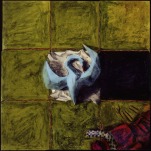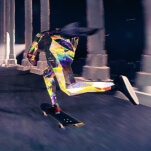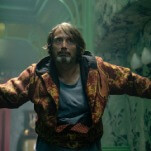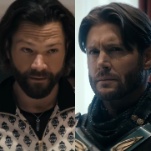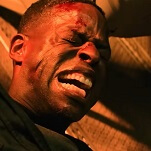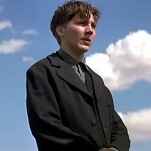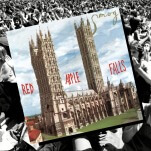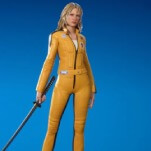In 1975, cartoonist and children’s book illustrator Stuart Hample had the bright idea to take the luckless, lovelorn, philosophical persona of Woody Allen—then famous for what the aliens in Allen’s Stardust Memories would later call his “early, funny films”—and turn it into a daily newspaper strip. Amazingly, Allen agreed, and even offered to provide Hample with a thick stack of pages compiled from his old notebooks, full of jokes and fragments of ideas. In 1976, Inside Woody Allen debuted from King Features, and it ran until 1984, by which time Allen’s stature in popular culture had shifted from “likeable comic type” to “aloof arthouse filmmaker.” The strip, however, kept harvesting the same fields for eight years, telling jokes about neuroses, therapy, and romantic woes as though Allen had never stopped making Play It Again Sam and Annie Hall. The thick, hardcover best-of collection Dread & Superficiality: Woody Allen As Comic Strip (Abrams Comicarts) is hardly a repository of classic comics; the strips have an appealingly curvy style, and some of the jokes are clever, but mostly this is 200 pages of variations on the same five or six comedic ideas. Still, Dread & Superficiality is a must for Woody Allen fans, both for its reminder of how iconic he used to be, and for Hample’s frank introduction, in which he writes about working with Allen in the early days of the strip. While the syndicate was pushing Hample to go broader and cuter, Allen was sending Hample notes encouraging him to use more non sequiturs and more tidbits from real life. Allen’s instincts were good, as Hample now acknowledges, but the cartoonist bowed to pressure from his bosses, and Inside Woody Allen continued without much input from its title character. The intro to Dread & Superficiality is a keen dissection of how a good idea can go awry, and how a public figure can lose control of his own image. But that dissection only covers the first few pages; the rest of the book is one long illustration of Hample’s failure… B-
Here’s something comics fans might be surprised to learn: The Family Circus used to be funny. When cartoonist Bil Keane launched the feature in 1960, he had more than a decade of experience generating topical gags and puns for newspapers and magazines, so he hit the ground running with his new strip, delivering tart little jokes about suburban life that split the difference between New Yorker sophistication and sitcom broadness. Reading the first volume of the new Family Circus anthology series, it’s initially striking how different all the characters look. Billy and Dolly and Jeffy (no PJ yet) are fairly close to the way they are today, but the mother’s a little off, and the father looks and acts like an entirely new person. He’s more of a generic early-’60s dad, smoking and drinking and ogling women between bouts of dealing with a house full of hell-raisers. Very little is cutesy about the cartoons in The Family Circus: Daily And Sunday Comics 1960-61 (IDW/The Library Of American Comics). It’s just punchline after punchline about toy-strewn floors and unpaid bills, delivered with a clean drawing style and a visual wit that Keane would soften over time. As IDW’s series continues, it’ll be interesting to pinpoint the moment when a once-snappy comic turned fluffy… A-
Pity poor Nick Fury: Not only has he been driven underground by the whole Civil War/Dark Reign mess, in Secret Warriors Vol. 1: Nick Fury, Agent Of Nothing (Marvel) he discovers that his S.H.I.E.L.D. agency has long been a cat’s-paw for its archenemies. Co-written by Brian Michael Bendis and rising star Jonathan Hickman, Secret Warriors focuses on Fury’s efforts to fight the good fight from the underground by assembling a team of likeminded, far greener heroes. The central twist doesn’t stand up to much scrutiny, and this first collection of the series—with art by Stefano Caselli—mostly lets the young heroes serve as background characters for a Nick Fury story, but it’s still an involving, well-told tale of intrigue and outsized action and a promising series start… B
A series long, long in the writing, thanks to Damon Lindelof’s day job as one of the big brains behind Lost, Ultimate Wolverine Vs. Hulk (Marvel) attracted the wrong sort of attention when it disappeared for years between issues. It was finally completed this year, and newly collected as a hardcover; now it’s easier to appreciate Lindelof’s playful upsetting of expectations. The series opens with a big fight rather than building to it, then keeps zig-zagging as the story’s chronology gets twisted and characters never behave as expected. Not everything works, and sometimes the sidestepping can be a bit much, but it’s a nice break from the expected, and a fine showcase for the sketchy kineticism of artist Lenil Yu… B+
Wolverine, the regular-universe kind, gets another workout from a Lost writer in Logan (Marvel), which teams up writer Brian K. Vaughan (in what’s likely to be his last work with a company-owned comics character) with 100 Bullets artist Eduardo Risso. Their three-issue series is now available in hardcover; it returns Wolverine to Japan for a pair of fights, one during World War II, and one taking care of unfinished business in the present day. The central twist is best left unrevealed, but it gives the series added resonance. Nothing here finds a new angle on the hero’s personality or troubled past, which probably says more about the difficulty of making a Wolverine story seem fresh than it says about Vaughan and Risso’s talents. But it’s a solid, memorable tale nonetheless… B
Writer Adam Rapp and artist George O’Connor find new levels of bleakness in their all-tunnel-and-no-light story Ball Peen Hammer (First Second), which is set in a dystopian future where disease and totalitarianism have combined to make humanity more miserable than before. More No Exit than Blade Runner, the graphic novel wears its symbolism boldly; much of the plot concerns unseen powers-that-be co-opting the living into murdering minority children with the titular tool. O’Connor’s art gives it a visceral presence, and it’s a tough book to forget, but the unrelenting bleakness ultimately works against it. It’s a blunt instrument of a different kind… C
Crime comics have had a heartening comeback over the last couple of years, and the new Dark Horse collection Noir offers a fine sampling of who’s who in striking black and white. Veterans like Stray Bullets’ David Lapham and Dean Motter, who offers a Mister X story, appear alongside newcomers, and the collection is unavoidably a bit hit-or-miss. But that says more about the breadth of the talent attracted to the genre than its viability. Tonally, the stories range from grim to grimmer, but they showcase a thrilling variety, and while they don’t all connect, there’s scarcely a hardboiled cliché in sight. The future looks bright for darkness… A-
The slim one-shot Sugar Shock: Don’t Be A Viking (Dark Horse) collects the Joss Whedon-penned/Fabio Moon-drawn story of an all-girl (plus one robot) rock band that travels to space for a battle of the bands (only it’s not really a battle of the bands). It’s a fun throwaway filled with absurdist gags that connect (a description of “the saddest song in the world” that captures the difficulty of writing about music) and some that don’t (a running gag about Vikings). It’s a goof, and proud of it… B
Back in the ’80s and early 1990s, Keith Giffen and Robert Loren Fleming’s Ambush Bug series used a minor supervillain as a springboard for hilarious metahumor about the absurdity of the comics world. The character has appeared sporadically since then, and when it was announced last year that the team would be bringing him back for a new miniseries, fans wondered whether A.B. would still work in the era of blogs, snark, and comics self-awareness. Ambush Bug; Year None (DC) just wrapped up—with issue #7 of a six-issue series—and it proved that we’re still in good hands with Giffen and Fleming. There’s been plenty of absurdity in comics since 1992, when the Bug had his last title, so there’s no shortage of material for the duo to savage—and “savage” is the right word. Giffen has gotten meaner in the last decade or so, and Nothing Special reflects that sensibility. It works surprisingly well; the nasty edge both mirrors and satirizes the direction the industry has taken, and it’s a hell of a funny read… A-
From Sid Jacobson and veteran artist Ernie Colón—the team that created the surprisingly effective illustrated adaptation of the 9/11 Commission Report—comes Che: A Graphic Biography (Hill And Wang). Neither a fawning hagiography of Fidel Castro’s partner in building post-revolution Cuba nor an excoriating attack, it comes across as much more even-handed than many more mainstream books on the subject. It also goes the extra mile by putting Che’s life (and death) in a greater historical context, providing it with a focus that’s lacking in many facile cartoon bios. Its biggest flaw is its brevity—at 128 pages, it’s long for a graphic novel, but short for a full-fledged biography—and at times it feels like the story’s being rushed. Still, a worthwhile effort from a team that’s doing interesting work in the format… B
After spending a lot of time at DC, with generally good results, Greg Rucka got the urge to return to his hardboiled crime-comic roots, and the result is Stumptown (Oni). The series follows Dex, a run-down female private investigator based in Portland, and the character is a winner right off the bat: She combines the splintered idealism of a Raymond Chandler character with the slack, breezy nature of a ’70s TV detective. (The Rockford Files is an obvious influence.) Rucka plans to make Stumptown an ongoing series, and is already populating the margins of the story with characters we’ll no doubt be seeing again, and he’s found a great art team in Matt Southworth and Stefano Gaudiano, whose clever use of panel layout serves the story well. Rucka tends to get bored with his stories, so there’s no telling whether he can keep it up, but the first few issues of Stumptown get the book off to a highly enjoyable start… A-
Given that Bill Willingham’s Fables is drawing from the entire body of fairy tales, folklore, and popular children’s literature of the last millennium or so, there are a nigh-infinite number of possible spin-offs, and given the series’ runaway popularity, it’s a big of a wonder that there’s only been one so far, the hit-and-miss comedy Jack Of Fables. Sometime House Of Mystery contributor Chris Roberson tries a different tone with issue No. 1 of the six-issue mini Cinderella: From Fabletown With Love (Vertigo), an adventure that sets up Fabletown’s most dedicated spy on a mission to find someone who’s selling magical artifacts into the mundy world. The first issue is briskly paced and densely packed, with more background for Cinderella and a lot of connections with Fables; it actually reads exactly like a stray issue of that title, with a continuity and attention to detail that’s great for fans. Who knows where this is going, but at the moment, it has a dynamism that its parent title sometimes lacks… B+
Writer-artist Larry Marder has always labeled his Beanworld series “a most peculiar comic book experience” rather than just a comic. But it plays more like a puzzle-solving videogame—the kind where each new discovery naturally opens up a tree of new possibilities. The original indie comic played out from 1985 to 1993; apart from a one-shot issue in 2008, the story has been left fallow ever since. Marder returns with the all-new trade hardcover Beanworld: Remember Here When You Are There! (Dark Horse), which looks and reads as seamlessly as if he had never left off. (Newbies can pick up the rest of the series via Dark Horse’s recent matching reprint volumes, but a brief primer at the beginning of the new book explains most of what they need to know.) Once again, the majority of his weird little black-and-white bean people are placidly living out their highly idiosyncratic lives, carrying out a circle-of-life cycle set in motion by Gran’Ma’Pa, the tree that overlooks their little island world. Meanwhile, a scientist bean and an artist bean make new discoveries daily, about how all the strange parts of their world interact and can be recombined to new effects. Most of Beanworld is driven by a placid what-will-happen-next wonder; there’s little fear or trouble in Marder’s world, apart from occasional pained concern by those who want to learn more, faster, and are troubled by their own lack of understanding. And Marder sometimes lapses into an irritating cutesiness, particularly with the baby-talking “Pod’l’pool cuties,” the mini-beans who are just coming into their own. The whole thing is, as Marder says, very peculiar. But it has the internal rhythms of an excellent poem, and a strong and striking vision that’s entirely unique. In spite of the vague lesson about how environments are interconnected and we’re all part of a connected chain of life, there’s rarely any sense that any of this means anything, and yet it’s strangely addictive, like watching a civilization build itself within a bottle. Marder has said that this book represents the end of the “springtime” Beanworld cycle, with more books to come. Here’s hoping it all makes sense someday, but failing that, here’s hoping he doesn’t let the story languish for another 15 years… B+
The Good Neighbors Book Two: Kith (Graphix) solves a lot of the problems of the first volume: The aimless, meandering story resolves into a direct conflict between Faerie and humanity, particularly via the decisions of the protagonist, half-faerie Rue. The stakes are high and the outcome is surprising, which on its own is enough reason to tune in. And yet this installment still goes in too many directions, as Rue’s various friends experience life and love crises that get a page or two of attention each, which isn’t enough to make them significant, but still muddies up the central conflict and makes it seem less urgent. And the events often seem pretty arbitrary; given that Rue is coming into a world she doesn’t understand and has only recently become aware of, it makes sense that she doesn’t know the rules, but they never really become clear for readers, either. Author Holly Black (co-creator of the Spiderwick Chronicles) gives the book an unpunctuated pacing that undermines her more dramatic moments, and Ted Naifeh’s art—so striking and idiosyncratic in his own cartoonier, clean-lined Courtney Crumrin books, but striving for more realism here—doesn’t always distinguish between characters well enough to keep the sprawling cast clear. Kith is a distinct improvement over Book One: Kin, and the promising ending can be read as a finale or a path opening up to endless adventures, but there’s still some frustration over the ways these books could have been sharper… B-




